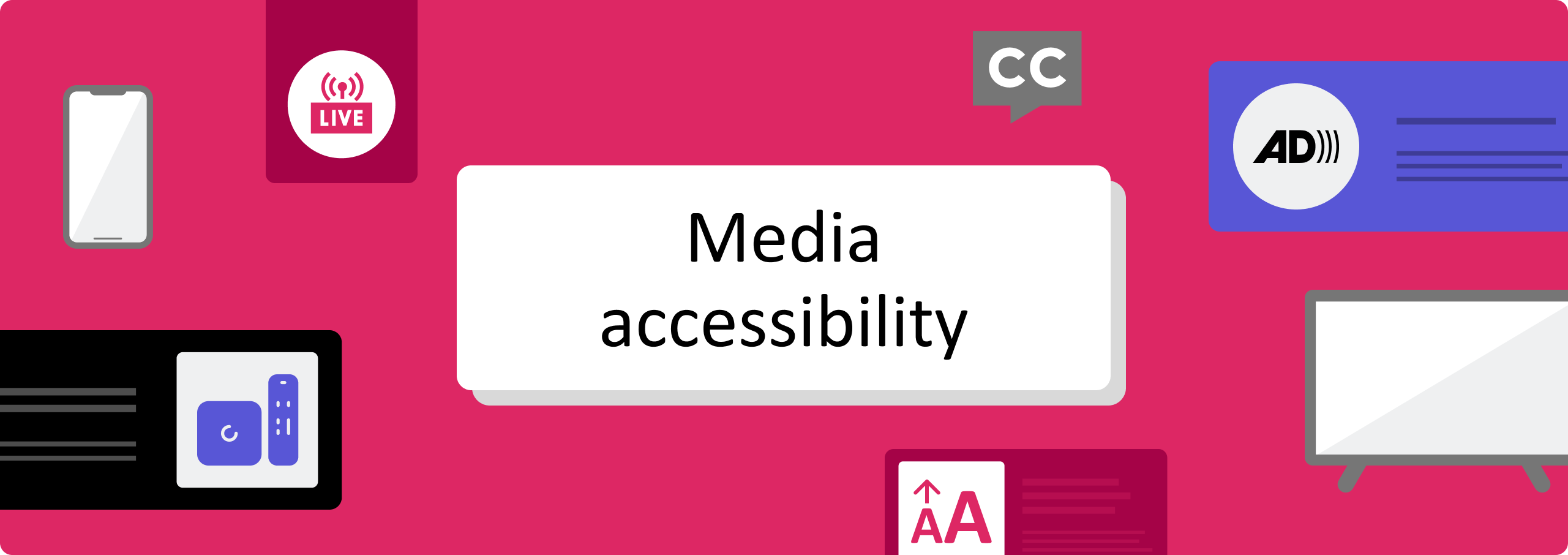
Insights: Media accessibility
“You can’t handle the truth!”
“D’oh!”
“How you doin’?”
“May the Force be with you.”
“Oh, my God! They killed Kenny!”
“You had me at ‘Hello.’”
You probably know exactly which movies and series these phrases come from (check the end of the article for the answers). Media shapes our culture and fuels our conversations, making it a significant part of our social lives. Beyond entertainment, media also keeps us informed of what’s going on in the world.
But what happens when media isn’t accessible to everyone? People are left out of these shared experiences. Fable recently surveyed our community to understand the accessibility of Smart TVs, cable and satellite TV, set-top boxes, and streaming services. From the survey results, it’s clear that media companies are considering accessibility in their products, but that there’s still a lot to improve on.
To dive deeper into these findings, watch a recording of the Fable Insights webinar with Kate Kalcevich, Head of Accessibility Innovation at Fable and Keely Cat-Wells, Disability Rights Advocate and CEO at Making Space.
TV accessibility lags behind computers and smartphones
Only one in three survey respondents found their Smart TV has all the accessibility features they need.
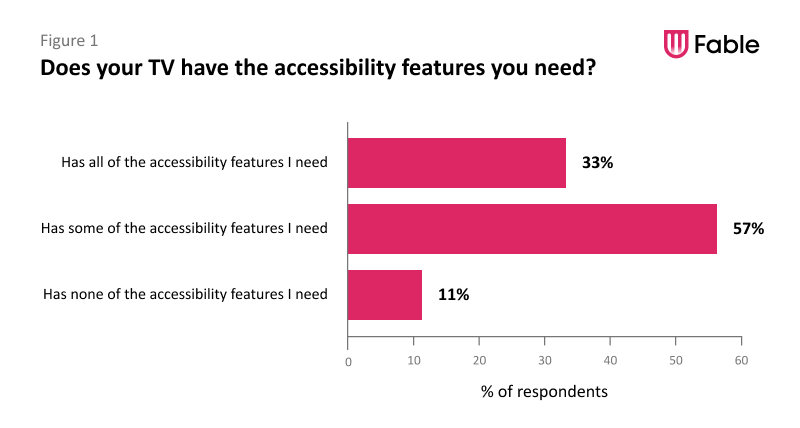
“The tools they provide, or the settings, are woefully inadequate. Using voice control, does not make up for being able to use magnification the way I would like to use the device. I am ‘forced’ into accepting what is available, and try to make the best of it.”
— Kostantino, screen magnification user
Some of that might be a lack of availability of accessibility features in the market, but it could also be influenced by not having enough information when buying a new TV. Respondents had an even 50/50 split on whether accessibility was part of their purchasing decision.
“The purchasing process was mainly only size and brand specific. At the time, I didn’t know TVs even came with accessibility, and it was a birthday gift for my husband.”
— Phoenix, screen reader user
Those that did consider accessibility had mixed experiences in getting the information they needed. Many did their own research.
“Most of the information I could find. Most of it required quite a bit of digging, though, which I know not everyone could do. They should make this information very clear upfront.”
— Emerson, screen magnification, voice control, and captions user
When it came to learning about accessibility features on TVs, respondents relied mainly on other people with the same disability (27%), the product manufacturer (24%), or a disability resource (24%).
Using accessibility features on a shared TV
When using accessibility features on a shared TV, there are sometimes other members of the household watching TV who may or may not be receptive to accessibility needs.
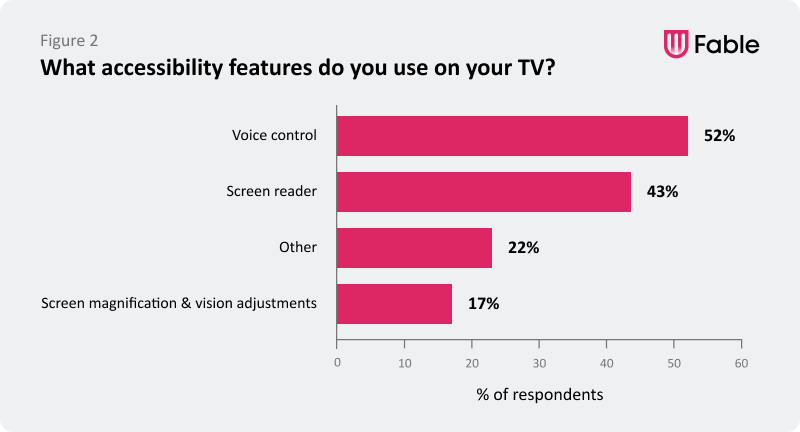
“My friends and family also enjoy the accessibility features even though they are not disabled.”
— John, screen reader and voice control user
“They don’t understand why I have to increase the font of the text on the screen. So I just have to stay silent as to not make a scene.”
— Alexandra, screen reader and screen magnification user
Challenges with TV accessibility
When asked what they wish their TV provider would change or improve, the top response was better training for customer service representatives in accessibility.
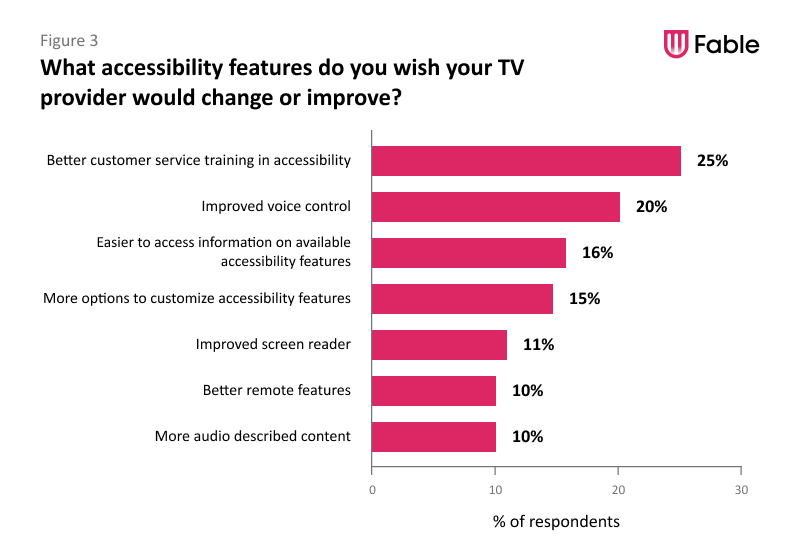
However, when you look at all the different assistive technology improvements together (voice control, easier access to and customization of accessibility features, and screen readers), there’s significant demand for improvements in that area.
“Voice guidance is a wonderful feature, but it’s just a little laggy, slow to respond and you can’t interrupt it easily without it going off on an unrelated tangent about the button you pressed. It also should include more verbosity features, allowing for user customization. You can adjust the rate and volume, but you cannot adjust how much or little info it gives you about elements on the screen.”
— Elaine, screen reader and voice control user
“Typically the TTS [text-to-speech] voices on smart televisions are very hard to understand or extremely loud compared to the television audio.”
— Serina, screen reader user
“My ability to use accessibility features is impacted. When I run Voiceview on the TV, it slows the TV to a crawl, forcing me to use other devices like Roku or Apple TV, which defeats the purpose of owning a smart TV in the first place.”
— Marina, screen reader user
Accessibility features are missing from set-top boxes
Only one in three respondents felt as though their set-top box had all of the accessibility features that they need.
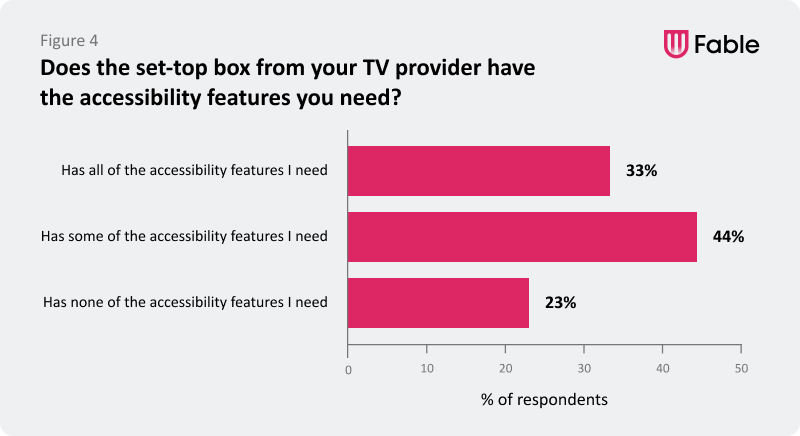
When it comes to accessibility features for Smart TVs and set-top boxes, Smart TVs come out slightly ahead with only 11% of respondents saying their TV had none of the accessibility features they need, compared to 23% for set-top boxes.
| Has none of the features I need | Has some of the features I need | Has all of the features I need | |
|---|---|---|---|
| Smart TV | 11% | 57% | 32% |
| Set-top box | 23% | 44% | 33% |
Availability of accessibility features on Smart TVs vs. set-top boxes
Has none of the accessibility features I need
- Smart TV: 11%
- Set-top box: 23%
Has some of the accessibility features I need
- Smart TV: 57%
- Set-top box: 44%
Has all of the accessibility features I need
- Smart TV: 32%
- Set-top box: 33%
Content is key for streaming services
Netflix topped the list of most popular streaming services used by Fable’s community:

When choosing a streaming service, the content available was the top consideration for the community at 88%, but accessibility and affordability tied for second place at 47% each.
The features respondents wanted most from their streaming service included more content with audio descriptions followed by better usability when navigating the content. Improved voice control was a close third.
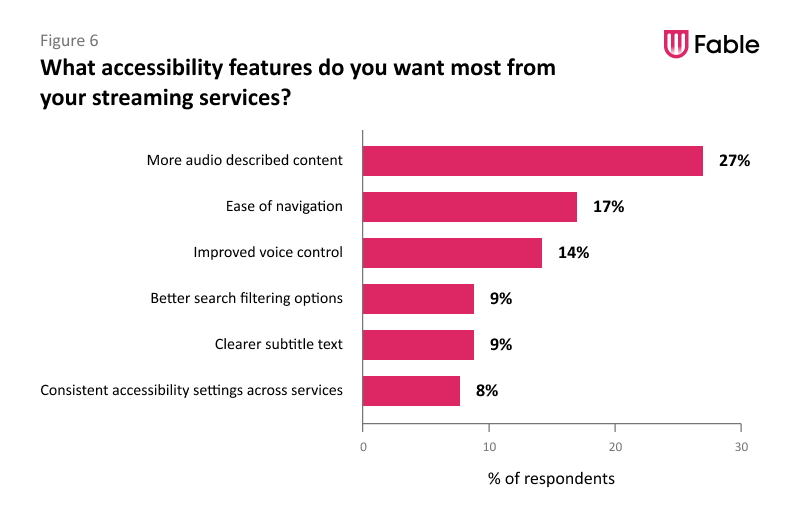
When comparing satisfaction with the accessibility of Smart TVs with streaming services, there are more people on the edges (very satisfied or dissatisfied) with their Smart TV than with streaming services. In both cases, there’s a large middle group of people who are somewhat satisfied or have neutral feelings about their accessibility features. There’s room for companies to capture a greater market share by providing excellent accessibility.
Satisfaction with the accessibility of Smart TVs vs. streaming services
Dissatisfied with accessibility
- Smart TV: 21%
- Streaming services 7%
Extremely satisfied with accessibility
- Smart TV: 25%
- Streaming services: 13%
| Dissatisfied | Extremely satisfied | |
|---|---|---|
| Smart TV | 21% | 25% |
| Streaming service | 7% | 13% |
Create customer loyalty through better accessibility services
Having an installer who is knowledgeable about accessibility configure their TV services can set people up for success and make a good first impression. However, nearly 60% of respondents felt as though their installer was not knowledgeable about accessibility.
“A tech did come to set up my box however, they did not know about how to activate the voice output on the remote nor the audio description.”
— Elizabeth, screen reader and voice control user
Media accessibility represents a large opportunity
The survey results from Fable’s community highlight the need for better accessibility in Smart TVs, cable and satellite TV, set-top boxes, and streaming services.
While some progress has been made, with most respondents finding accessibility satisfactory, there is much room for improvement. The survey underscored the importance of not only creating more robust accessibility features but also ensuring that information about these features is easily accessible to consumers.
The human element was critical for many with respondents who wished that installers and customer service representatives knew more about accessibility.
The accessibility of content was also a factor with 9% wishing for easier to read captions/subtitles and 27% hoping for more audio described content. Though it wasn’t a part of the survey, one respondent brought up the bigger picture of disability inclusive content.
“We would love to see greater inclusive programming of people with disabilities.”
— Mindy, captions user
Media companies have a substantial opportunity to increase customer satisfaction and loyalty by investing in improvements to accessibility features, training customer service representatives in accessibility, and ensuring installers are knowledgeable about accessibility features.
Fable Insights webinar: Perspectives on media, accessibility, and disability
Watch a recording of the Fable Insights webinar where Kate Kalcevich, Head of Accessibility Innovation at Fable and Keely Cat-Wells, Disability Rights Advocate and CEO at Making Space, dig deeper into the findings of our media accessibility survey.

